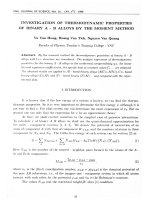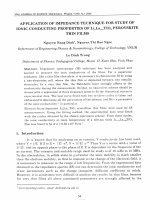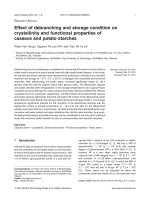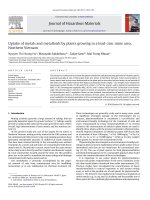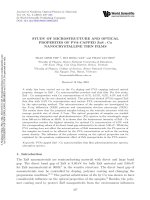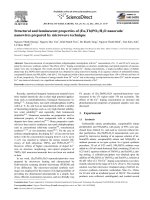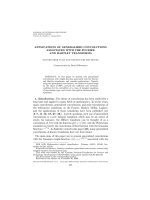DSpace at VNU: Investigation of Thermodynamic Properties of Binary A-B Alloys by the Moment Method
Bạn đang xem bản rút gọn của tài liệu. Xem và tải ngay bản đầy đủ của tài liệu tại đây (4.54 MB, 8 trang )
VNU. J O U R N A L O F SCI ENC E . Nat. Sci..
t.xv.
n^2
- 1999
IN V E S T IG A T IO N OF T H E R M O D Y N A M IC PR O PER TIES
OF B IN A R Y A - B ALLOYS B Y TH E M O M ENT M ETH O D
Vu Van Hung, Hoang Vail Tich, Nguyen Van Quang
F acu ky o f Physics, Teacher's Training College - VNU
A b str a ct. By the m om en t method the thermodynamic quantities of binary A - B
a llo y s w ith f . c . c s t r u c t u r e are co n sidered. T h e a n a ly tic e x p r e ssio n o f t h e r m o d y n a m i c
quavfiUes for the binary A - B alloys as the isothermal compressibility X t ^
linear
thermal expansion coefficient a, the specific heat at constant volum C y... are obtained.
The obtained results are apphed to A l - based binary alloys { A lC u , A l N i) ^ C u - based
binary alloys { C iiA l) and N i - based binary ( N i A l ) . . . and compared with the exper
imental data.
I. INTRODUCTION
It is known th a t if the free energy of a system is known, we can find the thermo
dynamic properties. So it is vory important to dpterrnine the free energy V' although it is
not easy to find Ỉ/'. For idial system one can determine the exact expression of
But on
general one can only find the expression for
by an approximate theory.
At first, wo shall restrict ourselves to the simplest case of pairwise interactions.
To calculatp Ự’ of biliaiv A B alloys we shall use the quasi-chemical approximation for
the multi - conipoiu'ut systeiiis [1, 2. 3]. We denoto th r potential of interaction of an
atom of ( oinponeiit A with that of componoiit B ^ a n d the numbers of atoms in these
cDinpoiHnit bv N a
The Gibbs froo orungy of such sVvStem can be written [2] as
G = Y ^ NAfiAA +
.4
Here
N
ab
M
ab
- kB TlnW {{N A ]. { N
a b
}),
(1)
A
is the nuinboi of the nearost - neighbor pairs formed by the atoms of the A -
th aiui B - t h C'ornpononts:
, f
-
ụ -A A -
ụ -B B
M a b = ------------- ------------- ,
(2)
where nj is the (first) coordination number; HAS = tí\ụ>AB\ is the chemical potential of
the pure A B subsystem, i.e., of the imagine one - component system in which all atoms
interact with each other by the potential ipAB and k'B is the Boltzman’s constant.
The values N a b and the statistical weight^VF obey [1] condition
41
Vu Van Hung, Hoang Van Tick, N guyen Van Quang
42
(3)
(4)
In the consideml case where the concentration of on<‘ component is small (for
example N b « N \ ) the quasi - chemical approximation leads to a raiulom distribution
of the pairs and we have
--
\N
~ Na + Nb ’
'Ăĩ
~ 2{ n I + N b )
/r\
^ 2{Na + Nb ) ■
Substituting (5) into (1) aiui taking into account (4) we get
( A '.4 + A b )!
G - G,\ + N b { 2 h a b - fiAA) - k s T l n — ^7 \jịỊ \ ’
(6)
wheiP G a is Gibbs free energy of metal A. In this paper, using the obtained in [4] results for
the Gibbs free eiieig.v GA of niPtal A and (6) WP investigate the thermodynamic properties
of b in ar y A ~ B alloys with face -centered cubic structures. The analytic expressions for
the thennociyuainic quantities as the thermal expansion coefficient Q, the specific heats
Cv and Cp, Pte. are obtaiupcl. The obtained results are compared with the experimental
data.
II. T H E EXPRESSION OF THE THERM ODYNAM IC QUANTITIES
FOR THE BINARY A - D ALLOYS WITH F .c . c STRUCTURES.
At first wr can find tlif> Gibbs flPO riif'igy of alloys ill the approximation form
analogous to (6)
C7 - G a + N u í ỉ i - T S c .
where
(7)
is the Gibbs energy change on substituting a single particle B and
„
(N_, + N„y-
is the entropy of mixing.
If only take into’ account the interaction of particles being on first coordination
sphere, we can find
= G - G
a
= ” (1 +
+ y'BA +
VMh + p
(9)
where A \ ' is the volume change on substituting a particle 5 , Ui is the number of particles
being on first coordination sphere, V’-4v4 is the Helmholtz free energy of a particle of A
metal in [4] [Nĩị'AA = ỳ'A arid N a + N b =
is the Helmholtz free energy of an
Investigation o f T h e r m o d y n a m ic P ro p e rtie s o f B in a r y A - B Alloys by.,.
atom B with atoms A boiiig on two first and second
of th(' iniagiiu'd one - coinpoiiont system in which all
potential í:^h a ^‘^ a b
fhi* Helmholtz freo energy of
tli(' tirst coordination sphero in the imagined system
uiln'i bv t h r potontial
with otht’i oiH*s by tli(‘ Ị)otíMitial ự>AB
43
coordination spheres, i.e., of an atom
atoms interact with each other bv the
an atom A with an atom B being on
in which all atoms interact with each
the first coordination sphere interact
Siiỉ>stitutiiifj (9) into (7) we have found the Helmholtz free energy V’ of binary A B
allovb (in the case of the pressure p — 0)
ụ ^
wlu'K'
U'A
\ is
^
d e t e r n i i n o d
(/'4.4 + ^ ' b {v 'b a +
by the moment
n i o t l i o d
( 10)
-TSc,
and equal to
4
0.4.4 = 3 { ^ + ỡ [ , T + / n - ( l - e - 2 " ) ] } ,
( 11)
Ĩ
r*fìí-ì»» poteMitial
f i <1I energy
Z
1 betwoen
1
- zero-th
*
4-K and
«
i - th particles of A
-rA.Ao
iiH 'ia l,
i ' Ị ị .\
iiiT t'ia c tio n
has
H
form aiialoí2,ous to
( 1 1 )
but
p a r a n i e t o r
k in this case has the form
( 12 )
111 t l i i ’
.\ot(' that the ini (>1 act ion potential
a Ị ) ] ) i o x i n i H t ( ' form
l)P t\v ('('n
i - th paiticlo A and B one is oftPii used
(13)
'riK'K'forc, \V(' {-ail (l('t('imiii('
]>aiauK'tf‘i /.■ aiiil //{) c\rc (‘fpial to
— f''A + 7 [ (
analogously as (11) with the aid of (13), but
- (
ớ'V4/A(ri)
dì! p
)J
=
luHí' tlií^ ladiiis ot tho /.' - tli coorclination spliore is detenuiiu'cl by r^. —
(14)
in which r\ is
th(' ùist c o o i d i i i a t i o n spliero (in t h e cas(' o f f.c.c l a t t ic e Uk eq ual to Ỉ^I = l , ỉ /2 = a/2) and
a
is rli(' nearest neighbor distance at tem perature T.
If tho displaceniont of the particlf' from equilibrium position of perfect metal A is
denoted by ^0 [4], the (lisplarenient of the particle from equilibrium position of the pure
A B subsystem i.e., of the imagined one - component system in which all atoms with the
Vu Van Hung, Hoang Van Tick, Nguyen Van Quang
44
corresponding free energy V’/i>4 (or V’AS is denote by ;vi(oi
then expressions of th e
corresponding nearest neighbors distances at tem perature T are equal to
(15)
here oq is the distance a at tem perature o K and deteimiiiecl from experiment..
By the moment method, the displacement, of the particle of the metal A is considered
and is equal to [4
2 7.02
VỐ =
3 ^
■A,
2q2
Ả-4
0-2
3f)3
+
Ẳ-6
^40
«3 +
■0-4
k.^
.TCth.T
(16)
«1 = 1 +
13
47
,
23 2 ,2
1 3
0-2 = — +
i----— xxcthx
c i n x -+t — X cc m
t h XX -f+ - X cTii
cth X,
X,
ư
6
6
2
25
121
,50
o 16
3 1 4
^ 4
\
— + ^^.Tcth.T + — x cWi X + — .r cth .T + ^.T^cth .X ,
3
6
3
3
2
/
43
93 Ì .
169
x t n x H-------X: ^ c t h ^ . r + ^ . T ^ c t h ^ . T + ^ . T ^ c t h ' ‘ .T + i , T ^ c t h ^ x ,
0.3 = -
- T +T
o
*J
z
where the param eter k haa the form ( 1 1 )
1 V -
(d ^ ^ A ,A o \
,Jd^ipA.Ao\
and the teim s V( —
and \( dfu ^t^íì^ỉ
) are deteimined as in [6]. W ith
/e q ’ \
! eq
^ d u ị g / eq
the aid of (13) and (17) the expression of the displacement of the particle yi (or ya) has
a form analogous to (16), but the parameter k in this case has the form (12) or (14) and
the param eter 7 has thjP corresponding form
IB A = Ạ l A
+ 1 b )
1
lAB = 1A +
24
^ỡV A .4(ĩ•l)^
V
a ..4
duL
)eq
V
a . 4)e q
+
(18)
d ^ < ^ A A {r\)^
V d vĩn d u l
/egj
We notice th a t the nearest neighbor distance a of the binary A B alloy is approxi
mately equal to the distances ữA.QAB Oĩ a s A- Besides, from (10) we see th a t the Helmholtz
I n v e s tig a tio n o f Therm odynam ic P ro p erties o f B in a r y A - B A lloys by...
45
free ('Ii( i f>,v i,' is H fiuu tioii of the Ii(>an'st no ig hho i (listancp a. T h u s , pxpancling this f u n c t i o n
on tlic ncaiPst iK'iglihoi distance a in spcond order approximation, wo find the follov/ing
('XjJK'ssious
= iỊ' b
V' a
b
(o ) =
^'a
a
{<’ b
a
) + 2
b
{«a
b
) +
x ( a - ciaÝ,
da'^ J t
d'h'>HA
x(« - (ì b a Ý,
dn'^ /7 '
^
“
‘ ^a
b
(19)
Ý-
Fioiii the (lefiuitioii of the isothennal bulk modulo B'r with B y = y o { ^ ) r j , , the
K'siilts (10). (19) and miniiiiiziiig Ụ' : ( |^ ) y . y, ^ = 0. we can find the pquilibrium distance
a of binai A B allo\’ at t(nnpeiature T
(iV.i - II ị N u ) B ệ
(Ì
X n \i^
—
(A',t - i t \ Ni i ]) Dệ. a,x + N[iB .f-'\a ba + iì[NiiDệJ^ X ŨAB
^
u.siuii, thv theniiodyiianiic relations and the expression of the Helmholtz free energy
( 10 ). \V(' obtain tlì(' (‘xpicssioiis of
isothermal corupressibility
linear therm al
oxpaiision coi'fficii'ut o. the sp('cific heats (TV and Cj, of binary A B alloy. Where, the
isoĩhrnnal conipiossiiíiliĩy has tho fonn
_____a i Ề ) ’
\7 ’
2 '’ + Í 5 7 ĩ ( ị S ) T
(21)
2P + Í - X Ĩ '
hon
\ */■ - ^
y
- u “
(1 + ^'l) j \ T ' +
(\
+ " 1 \ r ' ' '^) ’
• hả - ^ i Ì^' {^' ^' í ì a )
r '
Oa^
= : i N -------da^
.
A'
*.l /í __ 1* i, O H N ú^m Ì)^
\I
= rrrrí
)/■
^>“
1
=
í
3.V^
diĩ^
"
Nr
.,1 _
1 . O ^ S l'a a )
(22)
Fruin lli(' (lofinitioii o f tho thornial (‘x p a i is i o n cơ(*ífic-ient, it is e a s y t o de riv e t h e
t’t'lluwiiiii fuinml a
n = - á ‘ « V l ĩ ! s ( 7S i ) = |1 - r „ ( l +
3n-^ "
ẰN^da. dt ì
+ c „ ( n « '’
(23)
wIk'K' a ' is the linear thcinml expansion coefficient of the metal A [4];
ri BA
and
d'^tBA
da.dtì
d'^ỶAB
\ da.dtì
(24)
Vĩi Van Hung, Hoang Vail Tich, N guyen Van Quang
4G
A p p l y i n g th(' Gil)l)s - l l t ' l i n h o l t z i ( ‘l a t i o n a iu l Tisiii^ (10) \V(‘ Hiui i!io ( ' x p r r s s i ) n for
ĩ h o (MU'r^y o f biliarv A Ỉ Ỉ alloy and so th e spociHc he at at c o n s t a n f volunu' r v lia,s t \\0 fo rm
—
1 ~ C i i i Ỉ - f /M )
"t” ( ' ỉ ỉ
A c c o i d i i i ^ ‘ 0 tlì('
lieai at c o n s i a i i t voliiiiH’ o f iiH'tal A [4j.
ill wliich r'^.' is t l i r
al)o\'(' o h t a i i H 'd i r s i i l t s . in 0](li*r t o find
p a i a i i H ' t e r s Ả-.
(2 5)
-f
\ \ v Iimst US(' íli(' ('xpi'i'ssioiis )ĩ th('
' Oi
d(‘fiu('(l l>y (12) (11) a iu l ( 1 8 ) c o i K ' s p o i u l i i i ^ t o th(' tV(’(' ('iK'i'^y
or
c.'f> a n d
ai(‘
t ' \}ỉ. T h ( ' spoc iíic h e a t at c o n s t a n t p i ( ‘s s i n 0
th (‘ aíliahaĩic coinpiossihility ;
n i ii u 'd f r o m fho k n o w n t l i o n i i o d v i i a i u i c I f ' l a t i o n s
9T\'a'
c , -
Cr
( 26)
f ' r -f
\7
A t l a s t . t h ( ‘ i s o l l u n n i a l a n d a d i a b a t i c l)ulk inochili D ị a n d
o f l ) i u a i \ ‘ A B a llo \'
ar(' ('(Ịual t o
Br= l/xr.
fi.S’ - l / v , , .
(27)
III. N U M E R I C A L R E S U L T S F O R A l C u . A l X i . C u A l A N D X i A l A L L O Y S
T h ( ' i n t i ' i a c t i o n p o t ( ‘n i i a l l)(‘t\ve en t w o a t o m s o f a iiK'tal is
list'd ill t h e f o iu i
of tlic n — fif oiii' [7j
f{r) =
IỈ
I)
ilt
ÌÌỈ
~
\ Ì' ^
/ /■() Vrn
(28)
- iỉ{ — )
r
fioiii tli(' ('xporinuMital ( l a t a a n d li.iii a r o (lotoniiiiK’s hv tli i‘
\vh<*r(' D . /■() a i ( ‘
('iu])irii al w a y (ill T ii\)\v 1) [7 .
Tl iP
I'omiltc; in
Al
‘2 nr*' nppìioíỊ t o
Uiuivtv ;\llov^.
{ A l C i i . A I N i ) , C i i - l)as('(l h i n a n ’ a llo y s ( C / / . 4 / ) a n d N i - hasf'cl h i n a i v a ll o y s ( N i A l ) w i t h
f.c.c s t n i c t u n ' {ii\ = 12). Us i ii^ (2 8), Tal)l(' 1 a n d ( Ỉ I ) . (12). (14). (17 a n d 18). \V(‘ o b t a i n
th(' v a l u o s o f ]>aiaui('t(ns A.
T l i r n ' f o r ( ' , fVoiii
I'i'snlts iU)(l (11) ( 1 5 ) (IG). (20)
(27)
\ vr o h t a i i i íh (' \ a l u ( 's o f till' cuiiiỊíios sihilitx' \ /-. liiK^ai' tlioiiiial ('xj)asicjn co( ‘fiic-i('nt a aiiil
c o n s t a n t - pK 'ss un* spfH’itic lu'iit C/> a t p i r s s u i o p = 0. T h o K' s ul ts for A l C i i . A Ỉ N Ỉ. c t i AỈ
a n d A ' /.4/ a llo y s a i r suniiiiariz(Hl in T a b l i ' s
4.
In th(' ca so o f A i . C n a n d N i p u r o m e t a l s {tlì(' c o ii c o iit ia tio ii o f a t o i i i s
B : c Ịi — ())-
í lu ' oỉ)taiiKHÌ K 'sul fs vvi'll coincidi* w it l i tli(' ('xpiniiiUMital (la ta (lal>l('s 2. 1).
F o r Al C' f i , A ! ! \ /. ( ’i i Al a n d N i A Ỉ a llo \' s ị C ỉ i < 0. 1) t h e calculatiHl l i 's u l i s for (\ a n d
C' r
a ls o c o i u c i d i ’ \V('11 w i t h th í' (\\p
M etal
n
m
ro(A°)
D/KB(«B)
A1
12.0
4.5
2.8541
2995.6
Cu
9.0
5.5
2.5487
4125.7
Ni
8.5
5.5
2.4780
4762.0
Table 1: E xperim ental values of param eters D, To [7]
lììvestigation o f Therrtiodynamic P roperties o f B in ary A - B Alloys by..,
Metaỉ
T("K)
A1
Cp (Cal/niol.K)
100
200
300
400
500
600
800
2.99
Õ.07
5.69
5.99
6.18
6.34
6.65
-
-
_
6.13
6.42
6.72
7.31
3.80
5.37
Õ.78
5.97
6.08
6.17
-
-
-
6.01
6.16
3.40
5.20
5.68
5.89
-
-
6.76
CPe.„[8]
Cu
Cp (Cai/mol.K)
Cp„.[81
Ni
Cp (Cal/mol.K)
Cp..,[8]
47
1000
1200
6.32
6.47
6.63
6.31
6.61
6.91
7.21
6.01
6.10
6.24
6.37
6.62
7.47
8.37
7.44
7.80
8.7
Table 2: The specific h e at at c o n stan t p ressure Cp of metal
Alloys
(■ii
O.Olõ
Cp (Cal/mol.K)
Cp,,„[9]
0,08
AlCu
NiAl
6.08
5.83
6.58
6,87
CuAl
Cp (Cal/mol.K)
5.85
C p ll9 J
6.43
Table 3: The specific h e a t a t constant p ressure Cp of alloys a t T em peratu re 400‘^K
- Allovs
_-
T"K
c-n
a.]()-VK
0
AlCu
a . i o 7K
0.045
100
300
400
500
800
1.18
2.32
2 .Õ0
2.65
3.18
2.32
2,-19
2.6 1
3.38
2.321
2.47
2.60
3.06
3.59
2.3Ơ
2.40
2.50
2.33
2.44
2.54
2.92
3.36
2.20
2 .;js
1
11__i .22
-- . .
1.44
a ..j9 j
a.io'V K
1.78
().u9 y
1.06
1 .6 G
1.74
1.80
1.97
2.10
2.26
a.xniSl
1.05
1.68
1.77
1.83
2.00
2.25
2.34
a . i o '/K
0.93
1.66
1.75
1.82
2.01
2.15
2.31
1.83
2.03
2.17
2.34
0,05
a„.„191
a . i o VK
0.08
.AlNi
NiAl
.......
a . i o VK
0.034
0
0.045 -
1200
a . i o 'VK
0
CuAI
1000
1.80
0.85
1.34
a ,..J 8 i
1.(56 I 1.75
1.66
1.7-1
1,82
2,29
2 ,! 5
2.59
3.05
3.58
2.19
2,37
a.l()-VK
0 .8 -Ỉ
1.43
1.50
] .56
1,69
1.78
a.xuíS]
a.lO'VK
0.62
1.27
1,38
1,52
1.68
1.78
0.71
l.M
1.52
1 .Õ8
1.73
1.82
..
1.30
Table 4: T herm al expansion coefficient a of alloys
2.01
48
Vu Van Hung, Hoang Van Tichf N guyen Vxr Quang
In conclusion, it should be noted that the moment m ethod really to iiiv^sngate tho
therniodynainic prop(*rtios of binary allovs with face - rentered cubic structin. Theso
results are light still for other cubic ones. However, we must notice th at thoi) paraiiietei
are (leterinined by other formulae.
In the following paper we shall use the results of this paper for the invetgation of
the therniodynaiiiic propeities of alloys witli other cubic* structure.
REFEREN CES
[1] J.L. Hill. Statistical Mechanics, Me Gray - Hill Book Company, NewYork 7oronto/Lon
1956: Izd. in. Lit., Moskva, 1960.
2] V. B. Magaliiisky. Izv. VU20V. Fiztka, No- 1(1976) 85.
3 V.B. Magalinsky. Izv. vuzov, Ftzika, No- 9(1997)17.
4 Nguven Tang and Vu Van Hung. Phys. Stat. Sol (b), 149(1988) 511.131(1990)
165.
5] Mark Mostoller and all. Phys. Rev. B, Vo. 19, No8(1979) 3938.
6 ] G. Leibfried and w . Ludwig. Theorịị of A n harmonic Effects in Crystals Ac a d e m ic
Press, New York/London, 1961.
7] Zhenshu, G. J. Daries. Phys. S t a t Sol (a) V. A78, No2(1983) 596.
[8] Arri,erican Institute of Physics Hand Book, New York (1963) 4- 66 -f 4- 0.
9] Metal Hand Book EdifAon 1948 (American Society fore metals) 811 ~ 143.
T A P CHÍ KHOA HOC OHQGHN, K H TN t . x v . n°2 - 1999
N G I I I Ẻ K C Ứ Ư C Á C T ÍN I1 C H A T N I1IỆ T Đ Ộ N G C Ủ A I Ĩ Ợ P K I M e M
THAY TH E A- B BANG PH Ư ƠN G PH Á P MÔMEN
Khoíĩ Vật Ịý - Đại học Sư phạm - DHQG Hà Nội
Bằng phương pháp mòmen, các đại lượng nhiệt động của hợp kim tha>thế AB có
cấu trúc lập phưang tâm diện đã được nghiên cứu. Biểu thức giải tích của cá'đại lương
nhiệt động như hệ số nén đằng nhiệt XTi hệ số dản nờ nhiệt a , nhiệt dung iêng đằng
tích C y ,... của hợp kim thay thế AB đ ã thu nhận được. Các két quả lý thuyt. được áp
dụng cho các hợp kim đôi AI (AlCu, AlNi) hợp kim đòi gốc Cu (Cu Al) và ^ (Ni Al)...
và so sánh với số liệu thực nghiệm.


